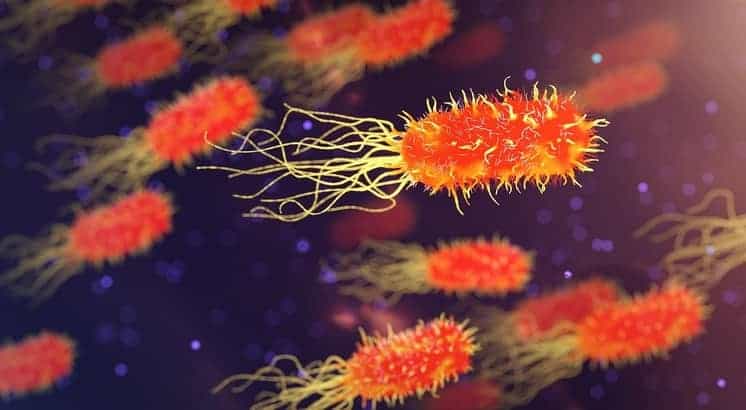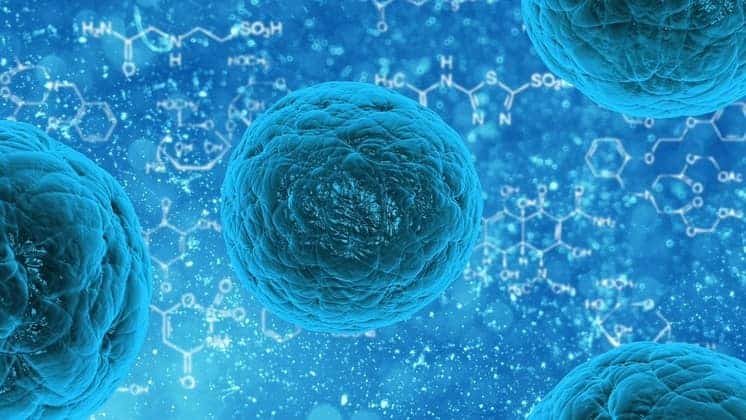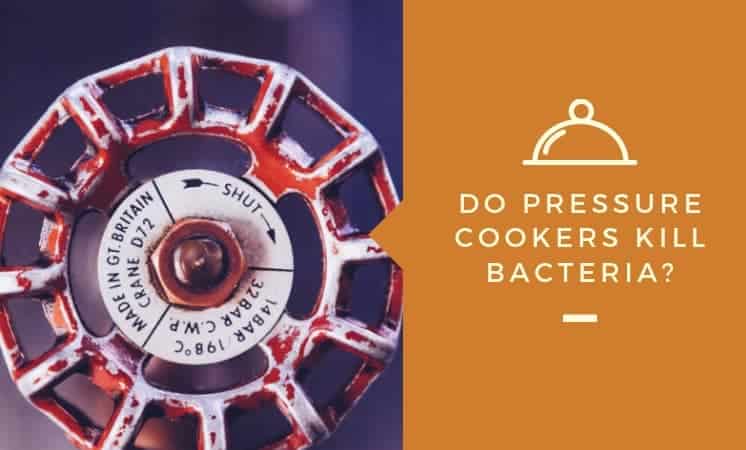Pressure cookers are praised for their ability to cook a large meal in less time than most other methods of cooking, and at the same time preserve a big portion of the nutrients in the food. But today we’re not focusing on nutrients or cooking times – we’re focusing on bacteria.
The principle used by the pressure cooker resembles the autoclave process, a process used in laboratories to kill bacteria. Knowing that the pressure cooker is somewhat similar to the autoclave process forced me to do research on the topic. This is what I’ve learned.
Do pressure cookers kill bacteria? Yes, they do. When cooking, the pressure in the pressure cooker increases the boiling point of water to 250F/121C which kills most bacteria and viruses. The combination of heat and pressure has been used to kill bacteria in the food industry for a long time.
With most micro-organisms, such as bacteria, bringing the pressure cooker to full pressure is enough to kill them. Unfortunately, that’s not the case for all types of bacteria that may be present in our food. Time and temperature are two other important key factors when getting rid of some types of bacteria. We’ll come to that later on!
The pressure cooker combines two very effective methods of killing bacteria – the exposure to heat and pressure.
Heat is undeniably an extremely effective way of getting rid of bacteria. Before the convenience of electricity came along, our ancestors used live fires to prepare their meals.
Today, the process of cooking is much simpler but the reason for doing it is the same – to kill bacteria that may harm us. Why high temperatures and fires kill bacteria may be easy for us to imagine, whereas, in the case of pressure, it might not be as obvious.
This Is How The Pressure Cooker Kills Bacteria Effectively

Luckily for us, exposure to high pressure is incredibly effective when it comes to sterilizing. The principle used by the pressure cooker is used on a daily basis in most hospitals to sterilize surgical equipment, laboratory instruments, and other tools used in environments that require them to be free from all sorts of bacteria.
The pressure cooker and the autoclave process both use the power of steam to kill bacteria, germs, and other micro-organisms that may be resistant to boiling water and strong chemicals.
However, just like the autoclave, the pressure cooker does not kill all bacteria right away. But bringing the cooker to pressure will kill most of the bacteria that are responsible for food poisoning.
But in the autoclave, which must use more radical measures, the content placed in the container must be exposed to the process for a sufficient period of time in order to be “sterilized”. In the pressure cooker, we’re not looking to sterilize – just getting rid of potentially harmful bacteria such as Salmonella, Campylobacter, Listeria, and E.Coli.
The method used by the pressure cooker comes with a few advantages that are well worth highlighting.
- The process of eliminating bacteria in the pressure cooker does not affect the taste of the food. For most other methods of cooking, creating an equally sterile environment would impact the taste and texture negatively.
- The pressure cooker can effectively reduce the concentration of aflatoxin to safe levels. Aflatoxin is a fungal poison frequently found in rice, wheat, corn, and beans. Just heating food to the
boiling point does not produce the same results.
- In the pressure cooker, you only need to use enough water to keep the pressure cooker filled with steam throughout the process. Thanks to this, the nutrients in our foods are not dissolved in water, instead, they are kept in our food.
- Following the theme of the bulletin above this one, the pressure cooker is quicker than most other methods of cooking and can, therefore, retain nutrients more effectively.
- Pressure cookers are very effective when it comes to reducing lectins, an anti-nutrient in grains. This makes the pressure cooker one of the best ways to prepare your beans and grains.
Can Pressure Cookers Sterilize Food?
Small pressure cookers should not be used to sterilize food. They can effectively reduce the number of bacteria in your food, preserve nutrients, and more. While it has been shown that the pressure cooker can indeed sterilize syringes and bottles – the tests were done under great supervision and enough gear to actually test the results.
Pressure cookers, well, electric pressure cookers more specifically, do have the ability to sterilize food but it’s preferable that one uses a pressure canner to sterilize food.
In order to sterilize food, the pressure cooker must cook at 15psi (pressure per inch) for about 30 minutes. Cooking in a pressure cooker for 30 minutes isn’t an extremely rare scenario (but it’s seldom required by recipes), however, most pressure cookers don’t cook at 15psi for the entire duration of the process.
While manufacturers may claim that their appliance cooks at 15psi, the claim may hide the fact that the pressure cooker only reaches 15psi during its peak – which lasts for a short period of time. In order to achieve sterilization, the pressure cooker would need to hold the same pressure levels for the entire 30-minute period.
This is where the two key factors time and temperature come in. In order to achieve sterilization in an appliance that isn’t capable of holding 15psi throughout the 30-minute period, one would have to cook for a longer period of time to achieve the same results. Therefore, it is possible but it rarely happens that anyone cooks food in a pressure cooker for that long.
Can Pressure Cookers Kill Botulism?
The bacteria in our food may, during their lifetime, produce their own toxins which can be very harmful to us. One of their creations is rather nasty. It’s called the botulinum toxin and causes an illness called Botulism.
Botulism is linked to food that hasn’t been canned properly and can in some cases be lethal – the toxin causes paralysis which may cause respiratory failure when it reaches the breathing muscles. The germ can survive in canned foods but thrives in soil. Foods with low-acid content are most commonly linked to the toxin.
To avoid Botulism completely, home canners should can food using a pressure canner and always follow the instructions for home canning drafted by USDA.
But what about the pressure cooker? How does it handle Botulism?
The botulism toxin and regular bacteria are two different things. The toxin itself is produced by the bacteria.
Botulism can be killed at high temperatures (250+ degrees Fahrenheit) in combination with high pressure. The spores created to defend the toxin are, however, extremely resistant and can withstand boiling water and blistering cold environments.
At temperatures above 120 degrees Celsius, the spores protecting the bacteria die. Pressure cookers can reach temperatures as high as 121 degrees Celsius, depending on what kind of food you’re cooking.
When cooking with liquids, a pressure cooker maxes out at 100 degrees Celsius. Even when cooking dry foods, the pressure cooker will only reach maximum temperatures in short intervals.
Therefore, the process of killing botulism in a pressure cooker is a difficult task, but it can be done – at very high temperatures for about 30 minutes. Well, it’s really the spores that are hard to kill, the botulism toxin itself doesn’t survive 10 minutes in boiling water.
With that said, I still recommend using the pressure canner in this endeavor.
Do Pressure Cookers Kill Toxin and Poison?

Toxins, poisons, and bacteria aren’t the same things. Sadly, you cannot really kill toxin and poison as they are not living organisms. Toxins and poison can only degrade, which they hardly do when cooked. Cooking food the point needed to completely exterminate toxin would render it inedible.
Looking at them individually tells us that poison can only be removed from our food, most effectively by washing the food thoroughly prior to cooking it – which only removes the poison on the surface of the food.
Toxins are generally found inside the food, some of the most concerning ones include:
- Mercury
- Added sugar
- Coumarin in cinnamon
- Mercury in fish
- BPA
- Trans fats
However, when it comes to food poisoning, you can prevent it by killing the bacteria, which the pressure cooker does.
Do Pressure Cookers Form Harmful Compounds Like Acrylamide?
Studies have actually shown that pressure cookers assist in the elimination of two harmful compounds that have been linked to the development of cancer – acrylamide and hetercyclic amines.
Acrylamide is a compound found in carbohydrate-rich foods that have been exposed to high temperatures – like french fries or potato chips for example.
Potatoes contain the amino acid asparagine, which produces the harmful compound when it’s heated to high temperatures in the presence of certain carbohydrates. Thankfully, anyone who uses a pressure cooker will be spared of these substances.
A team of researches conducted a study where they would cook potatoes in the pressure cooker for 20 minutes to see if the formation of acrylamide took place. The potatoes were almost entirely free from acrylamide when comparing them to potatoes that were prepared using other methods.
That’s because acrylamide is formed when cooking with dry heat, the pressure cooker is full of steam, creating a very moist environment. As long as there’s steam present in the sealed container, compounds like acrylamide won’t form.
Conclusion: Do Pressure Cookers Benefit our Health?
While most of the potentially harmful bacteria will surrender once the pressure cooker has accumulated enough pressure, some micro-organisms need to be exposed to high temperatures for a long period of time in order for them to be wiped out completely.
When it comes to retaining nutrients, the pressure cooker is quick and it uses small amounts of water which reduces the nutrient depletion to a minimum. The added pressure when cooking gives the pressure cooker an edge in this regard as it forces the heat to penetrate the food, reducing the cooking times significantly and killing bacteria.
In comparison to other methods, such as frying or boiling, the pressure cooker is a much healthier alternative.

